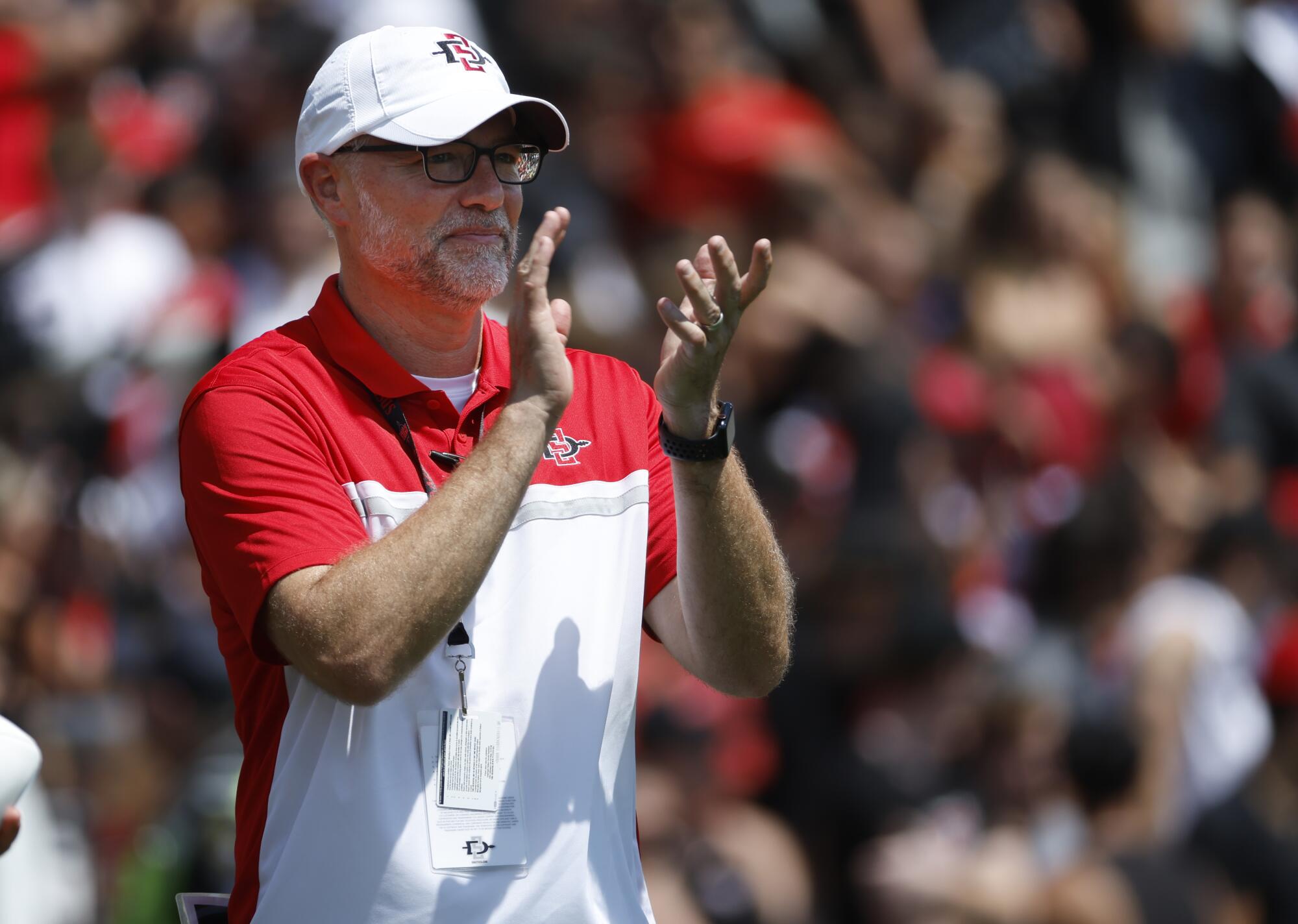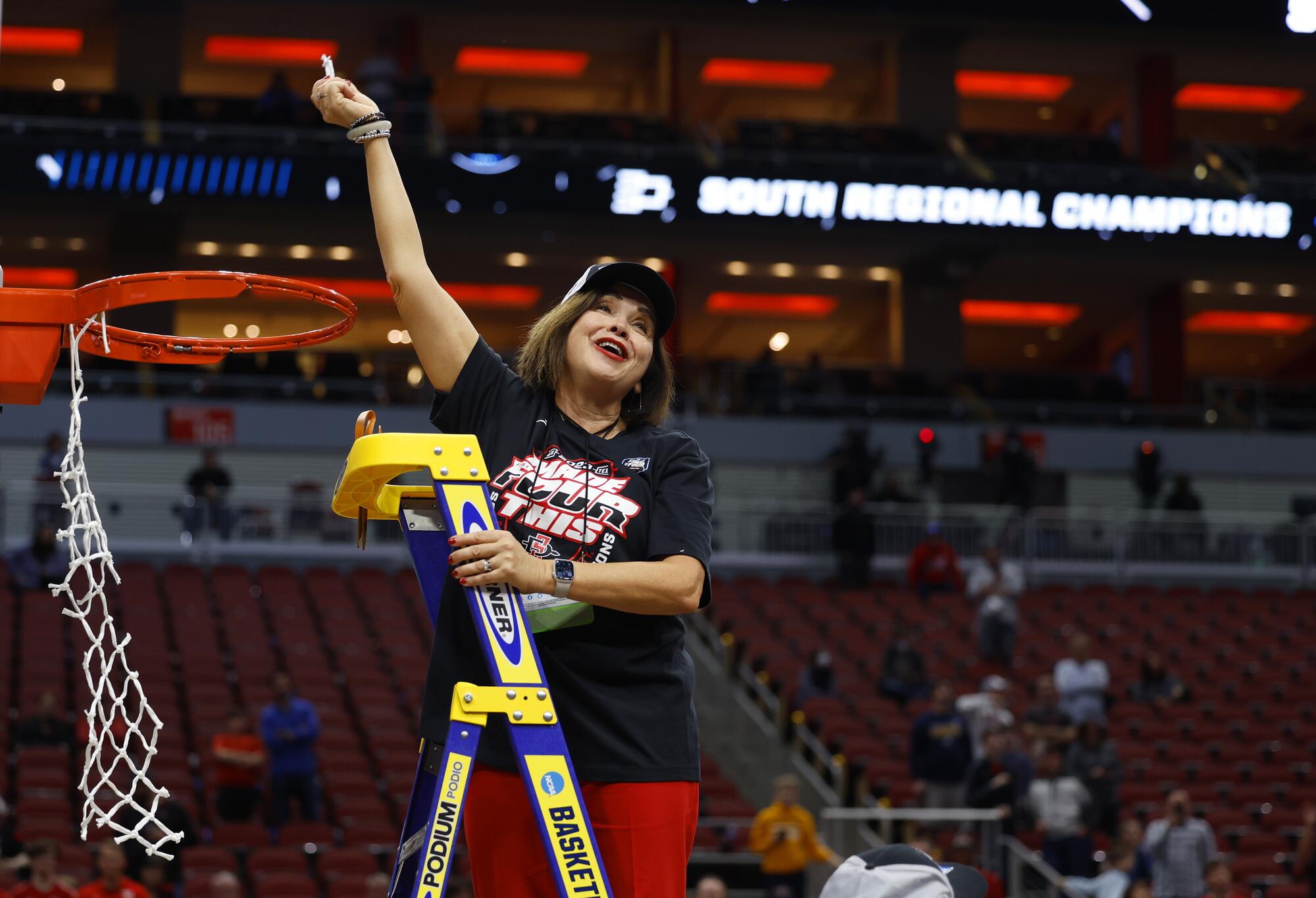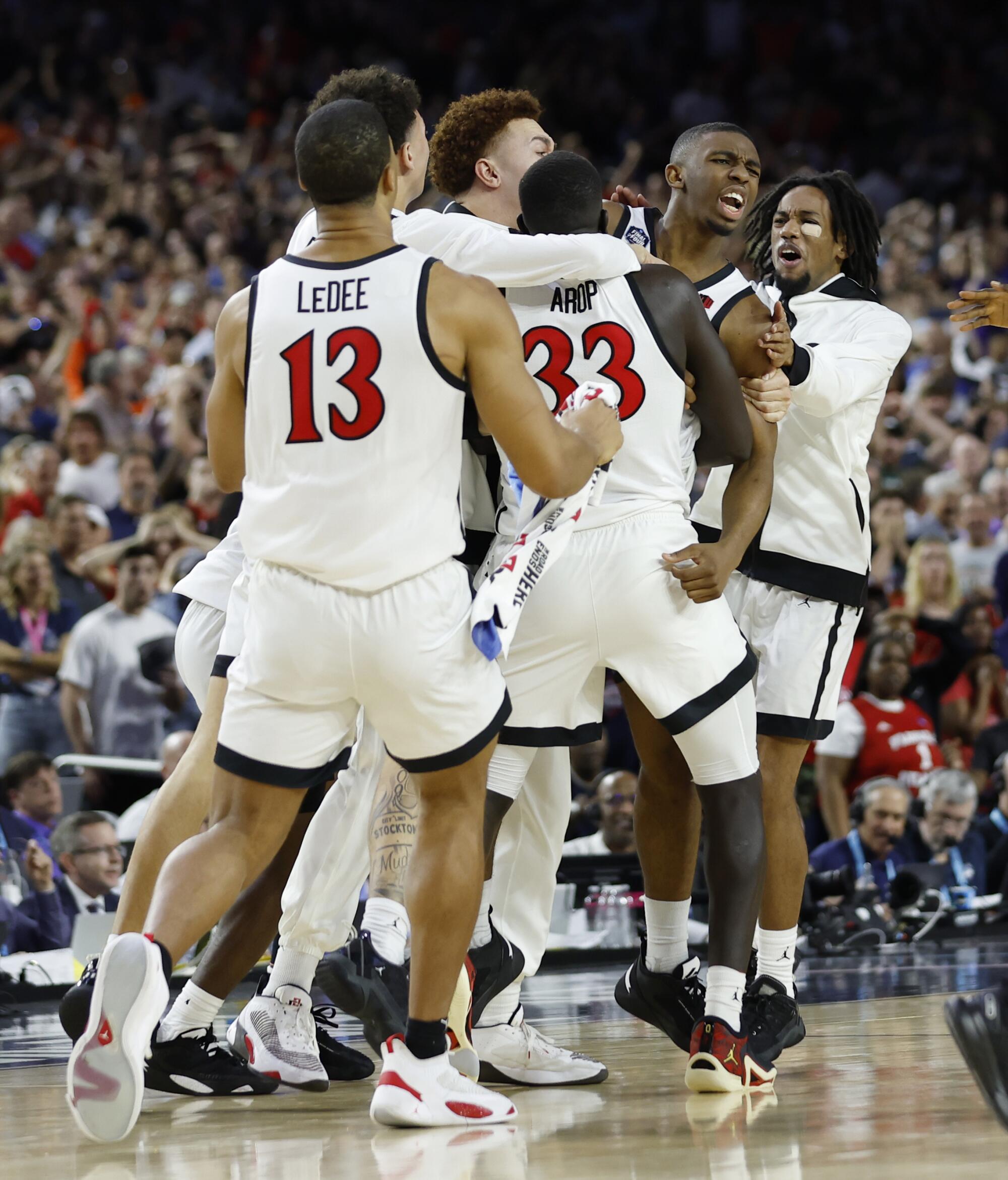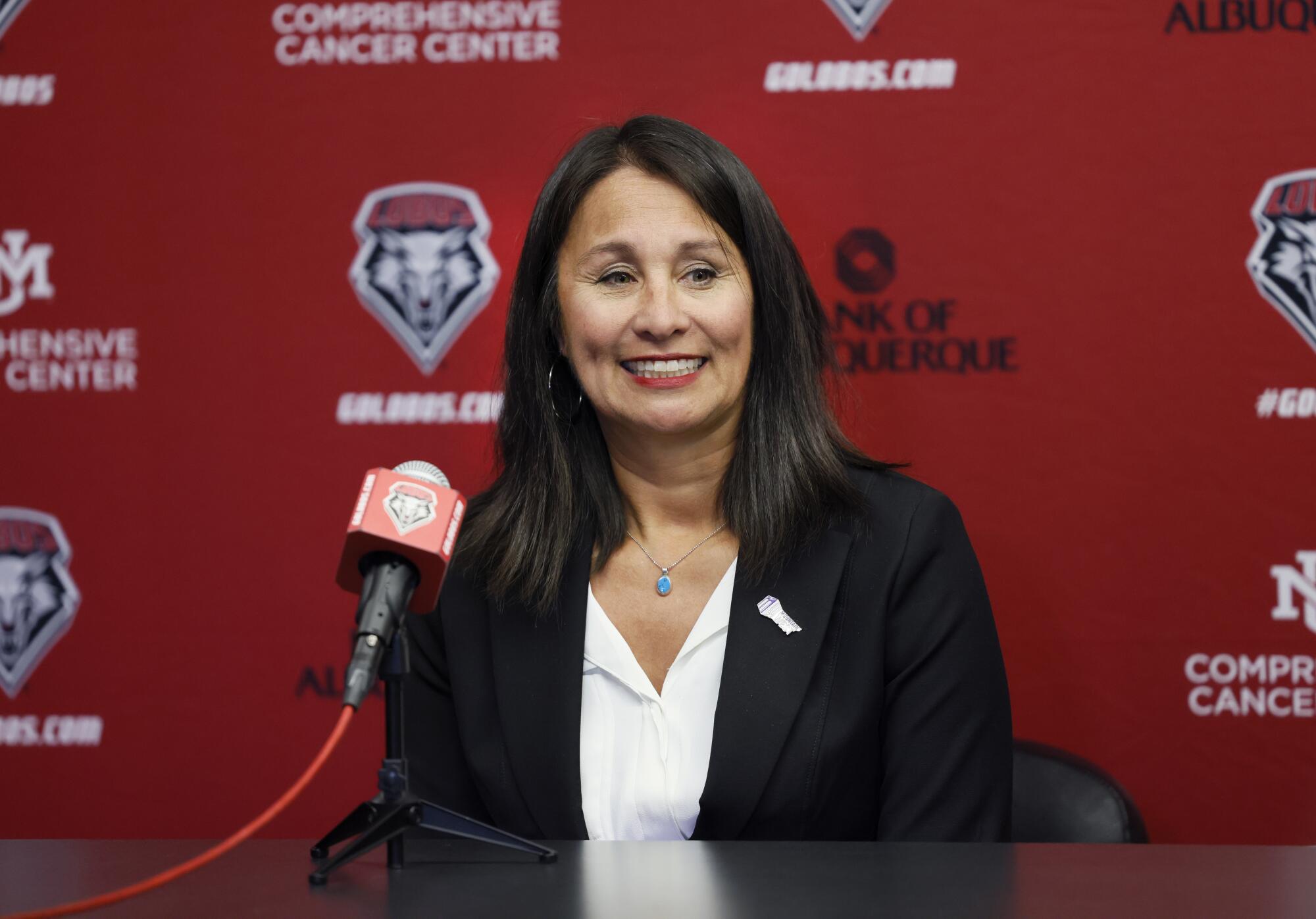
San Diego State must give notice to Mountain West by June 30 if it wants to play elsewhere in 2024-25 or the exit fee doubles to an estimated $34 million
Remember when a new Pac-12 media rights deal and expansion plans were supposed to be completed by Labor Day?
Then it was by late fall, then by the end of the calendar year, then within the first couple months of the new year.
“When I first took the job,” new Mountain West Commissioner Gloria Nevarez said, “I expected it to happen any day, any week, after Jan. 1.”
Then it was no later than the Final Four. Now, according to the latest reports, we might be talking mid-summer.
Which suddenly is a problem for San Diego State, considered the lead Pac-12 expansion candidate and one that offers the beleaguered conference a presence in Southern California following the migration of USC and UCLA to the Big Ten next year. The Aztecs have a June 30 deadline to notify the Mountain West of their intention to leave for the 2024-25 academic year or face double the exit fee.
“This is going to be a tight deadline,” SDSU President Adela de la Torre said, “there’s no question about it.”
“Yeah,” Athletic Director John David Wicker said, “it’s coming up quickly.”
Departure — or “resignation” in the Mountain West bylaws — before the current media rights deal expires comes with a financial penalty because, presumably, its television partners could invalidate the contract and renegotiate for less money without its highest profile member. Give a one-year notice by June 30, and the exit fee is triple the most recent average annual payout per school — estimated between $5 million and $6 million this year, or roughly $17 million total.
Leave after that for 2024-25, and the exit fee doubles to $34 million.
“We can’t pay the (extra) amount,” Wicker said of missing the June 30 deadline. “Everyone is aware of that, so we’re continuing to have conversations about that.”
So might they have to wait two years, until 2025-26, to join a new conference if an invite comes in July or later?
“I don’t think anything is off table at this point,” Wicker said. “But that would not be a desired outcome.”

The conundrum is this: The Pac-12 will be down to 10 schools and likely needs increased inventory from adding an 11th or 12th member to augment the value of a new media right contract, but it can’t extend invitations — and prospective expansion candidates might not accept them — until they know there’s still a conference to join.
“I’m really confident about our future in a Power 5 conference,” de la Torre said last week, speaking with the Union-Tribune at the announcement for an MLS expansion team at Snapdragon Stadium beginning in 2025. “I’m also confident that, when we talk about the Pac-12, they need to get the best deal possible for us to get the pro rata share we deserve.
“So I’m patient. I’m one of these very patient leaders. There are a lot of people who want to rush. I have a good relationship with a number of the presidents in the Pac-12. I know we’re the No. 1 (expansion candidate), that they believe in us, that they see their future with us. I’m optimistic. But there’s never a straight line to success.”

Especially not in the convoluted world of conference realignment. The June 30 deadline seemed so far away when news broke last summer of USC and UCLA’s exodus and the Pac-12 began considering replacement candidates. Now, suddenly, we’re inside five weeks.
The Pac-12 was next up among college football’s five power conferences for a new media rights contract, but the Big 12 jumped the line last fall and quickly cut a deal with ESPN and Fox Sports that will pay $31.7 million per year to each of its 12 members starting in 2025. New Pac-12 Commissioner George Kliavkoff has been frantically trying to cobble together a comparable agreement ever since, and now he’s doing it amid a deteriorating economy for media rights.
There are reports about the Big 12’s desire to poach the Pac-12’s so-called Four Corners schools — Arizona, Arizona State, Utah and former Big 12 member Colorado. Others have the Big Ten expanding again with Oregon and Washington to give USC and UCLA regional travel partners. New York Post sports media columnist Andrew Marchand said earlier this week that ESPN “has had no substantive talks with the Pac-12 in a while,” which leaves lesser networks (CW, Ion) or streaming-only services (Amazon Prime, Apple TV) that would put games behind a paywall.
The Pac-12 board issued a statement denying its imminent demise, saying its members had have “positive conversations with multiple potential media rights partners over the past weeks” and “look forward to consummating successful media rights deal(s) in the very near future.”
That was Feb. 13.
Is de la Torre worried the Pac-12 might by a Pac-4 by the time they get there?
“No, I’m not at all,” she said. “I don’t have even an ounce of doubt about that. And that’s because I truly believe you have a conference that really believes in having a West Coast presence, a presence that really is the West. Just like there were doubters about our basketball team, I think the doubters of the Pac-12 will be plausibly surprised in the future as well.
“There are a lot of issues, if you look at media rights and the media environment, in terms of a lot of transition, a lot more economic upheaval, and that makes it that more difficult to finalize a new contract. But I’m patient, and I know we’re going to get there.”
The composition of a media rights deal, though, is less important to SDSU than the timing. Does it happen before or after June 30?
“We have to wait for the Pac-12 to do what they’re doing,” Wicker said. “We’re having conversations with people on a regular basis. Everyone knows our timeline as far as that payout to be playing somewhere in 2024.”
One option is to negotiate an extension or reduced fee if they give their one-year notice after July 1.
How firm is the deadline and exit fees?
“Well, it is in our bylaws,” said Nevarez, who replaced Craig Thompson as Mountain West commissioner in January. “Certainly if (SDSU has) a request, our board would review it. I wouldn’t suppose how they would react to it. Like any buyout clause in a coach’s contract or an employee’s contract, it’s intended to make sure we don’t take a step back, that we either make ourselves whole or invest it in expansion. All those factors need to be considered.”
One argument for empathy is that the Aztecs’ historic run to the national championship game — no Mountain West team had made it past the Sweet 16 — is worth about $10 million to the conference in NCAA Tournament distribution shares over the next six years, and they would see none of that should they leave.

Cincinnati, Houston and Central Florida bargained down inflated exit fees when they left the American Athletic Conference for the Big 12. The fee was $10 million per school with 27 months’ notice and a whopping $45 million without, and their announcements came inside two years. They finally settled on $18 million each.
A dice-roll option for SDSU is to notify the Mountain West before June 30 of its intention to leave by 2024-25, banking on a) the Pac-12 staying together and b) extending an invitation.
There is some historical precedent. SDSU and Boise State submitted notices of resignation from the Mountain West in 2012 to jump to the Big East in football and the Big West in most other sports. The Big East fell apart in the interim, leaving both scrambling to return to the Mountain West.
It cost SDSU only $1.5 million to break its agreement with the Big West. A clause in its contract with the Big East invalidated any exit fees, and the $2.5 million exit fee it initially paid to the Mountain West was refunded when it returned.
The financial stakes are far higher this time. SDSU theoretically could pay $17 million to exit the Mountain West and then possible entry fees to rejoin if the Pac-12 evaporates.
“That’s a good question,” Nevarez said. “My gut reaction is if they were out, they’d be out. We’d move on, and if they wanted to get back in, they’d have to reapply.”
Another issue for the university is covering a significant loss of revenue by its athletic department during the transition to a new conference. When a school gives notice of departure, Mountain West bylaws stipulate that its payouts for that academic year and the next are frozen by the conference toward payment of the exit fee. The balance is due when the member officially leaves.
That means SDSU would be short $11 million-plus to balance an annual athletics budget that is approaching $70 million and, according to a database operated by the Knight Foundation, ran a $1.35 million deficit in 2022 while receiving 73 percent of its “revenue” from tax dollars, student fees or donations.
There’s also the Big 12, which reportedly has shown interest in SDSU in its quest to expand into the Pacific time zone.
But de la Torre and Wicker have expressed a clear preference for the Pac-12, both from logistical (do you really want to send your softball team to West Virginia and Central Florida?) and academic perspectives. SDSU has long aspired to gain membership in the Association of American Universities (AAU), a collection of 65 public and private research schools considered among the nation’s most prestigious; nine schools from the Pac-12 belong but only one (Kansas) from the reformed Big 12.
“It is an institutional decision, a presidential decision,” de la Torre said. “There’s no question that the Pac-12 academically, the AAU and elite institutions, the Stanfords, the Berkeleys, the University of Washingtons, those are all important for our institution and creating opportunities for our faculty and students. It’s not just an athletic conference. It’s a relationship with great institutions that San Diego State wants to be part of.”
She acknowledges this as well: “There are preferences and then there’s reality, and the reality will determine where we go.”

As for the Mountain West, Nevarez isn’t trying to stop them. She admitted they’ve already plotted next steps should conference realignment claim the Aztecs or any of the other 11 members.
“I would not be happy if they left us,” Nevarez said. “However, I told JD (Wicker), ‘I will not mount a campaign to keep San Diego State from doing what’s best for San Diego State.’ Look what the Mountain West did for TCU. Look what we did for Utah. I mean, we’re not going anywhere.
“We celebrate student-athletes when they go pro. We celebrate our coaches and presidents and athletic directors when they go on and succeed and become titans of their relative industries. As long as we collectively don’t take a step back and we continue to be well positioned in the 10 (Football Bowl Subdivision) leagues, I’m pretty psyched about the Mountain West.”
Sign up for U-T Sports daily newsletter
The latest Padres, Chargers and Aztecs headlines along with the other top San Diego sports stories every morning.
You may occasionally receive promotional content from the San Diego Union-Tribune.
